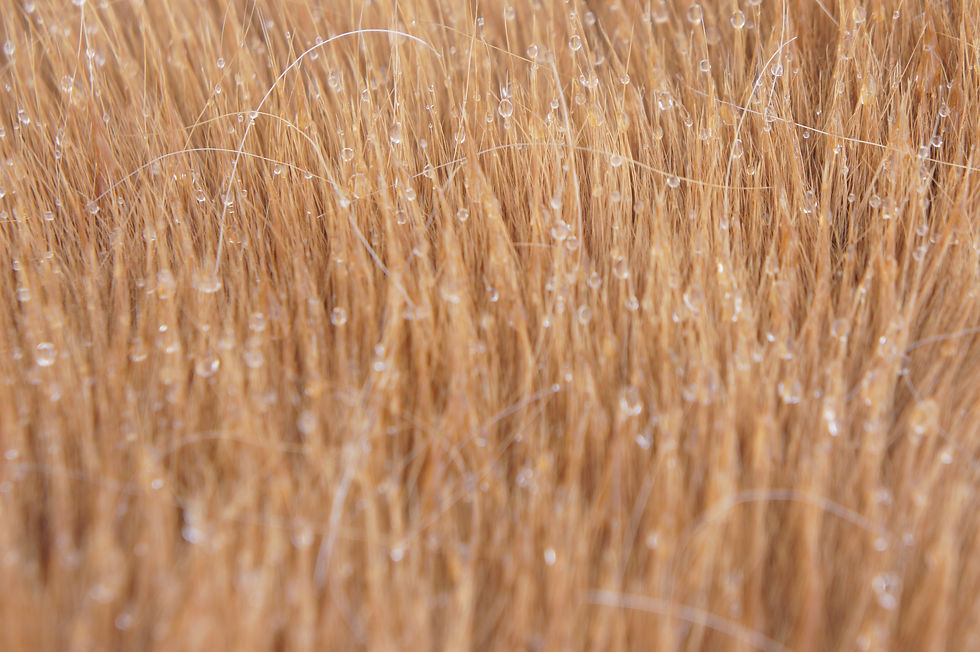Is my horse fat?
- Mindy Schroder

- Mar 18, 2018
- 4 min read
Updated: Aug 29, 2019
This is the time of year that I see people asking… is my horse fat? Then they post a photo of their horse. Sometimes they post a decent photo, but mostly I see photos of the horse taken from above, or in the barn so it’s dark and all you can see is the horse’s mane, or the horse has it’s head down eating.
Two things:
It’s nearly impossible to tell if a horse is fat from a photo. Though there are times when it’s obvious…

I think this mini is pregnant.
Most of the time it’s not really clear if the horse is in fact overweight or in good weight. Also most people who have horses that look like the one above KNOW it’s fat.
2. A photo taken at a poor angle will not show the horse to it’s best advantage. It’s difficult for people to give you an honest evaluation of your horse without a decent photo. I’m not talking professional quality here, just a decent photo.
Examples of a poor quality photo:
Below I show the same two horses, one photo taken at an awkward angle and one taken at a good angle. The photos below were taken 2 days apart. So not much can change in two days, but the angle and quality of photo makes a big difference.

Sky, 15 year old driving mare, 37″ tall. I took the photo on the left on 3/15/18 and the photo on the right was taken on 3/17/18.

Zorro, 3 year old gelding, 39″ tall. Again I took the photo on the left on 3/15/18 and the photo on the right on 3/17/18.
I put my fingers into Zorro’s hair coat so you can see how thick his hair is. This photo really only shows how long the main guard hairs are. What is difficult to show is how dense the under coat is. His guard hairs are about an inch to an inch and a half long. Especially on the bottom of his tummy. But that undercoat adds to the thickness as well. This can cause them to appear fat.

I will say that both of these horses are doing very well. They are neither too fat nor too thin. I can just feel Zorro’s ribs and have to push a bit harder to feel Sky’s. Sky is coming into spring in much better weight than she did last year. I was able to drive her lightly this winter and I have cut back their forage a bit. They all get low sugar low starch hay, but I feed a measured amount in their slow feed nets. They have hay for about 14 hours a day. They get 1/4 cup of Crypto Aero Wholefood with 1/2 a scoop of California Trace Mineral, 1 Tablespoon of ground flax (anymore gives Zorro the runs) and Zorro gets 1/2 a scoop of Excel for gut health. They get the grain once a day.
They are living on the track, so they move all day long. It’s a muddy, mucky, slushy mess right now so they have to work a bit harder to get around. That’s fine!! Exercise is good!
Bonnie is using the shed right now so these two are out in the weather a bit. They have wind breaks all over the track system, but they are roughing it. That is also fine as staying warm will help them keep the excess weight off as well. When Bonnie is feeling better they all have access to the shed. When we were -20 a few weeks ago they all three used the shed 24/7 for 3 days. Right now we are warm and wet so they are fine outside. That hair coat does it’s job very well and keeps them warm and dry!
Here is a cool shot of Sky’s coat up close with the water droplets on it. We were having quite a blizzard earlier and the water was beading up on her hair. The hair coat doing what it was designed to do!

Sometimes these easy keeper native breeds need to rough it a bit and forage for food to stay at a healthy weight. It’s good for them to have to work for their food a bit. I’m not saying they should be starved or forced to eat trees, bushes or weeds by any means. I will tuck small bits of hay all around the track, tucked under rocks and logs and I spread small piles of hay around when it’s not windy to encourage movement and foraging. When it’s freezing, below zero and windy, they get hay in the slow feed nets with some loose hay so they don’t have to stress, trying to get the hay out of the net while being too cold. But being outside in the weather will not kill them as long as they have wind breaks.
A horse is a horse and has been very thoughtfully designed to thrive on low quality forage while toughing it in the worst weather. Please know your horse and be aware if it’s feeling undue stress due to weather conditions, being too thin, feeling sick or is elderly and needs extra help when it’s cold. Act accordingly. But do understand, it’s nearly impossible for someone to be able to tell you your horse is too fat just by looking at a photo.





Comments